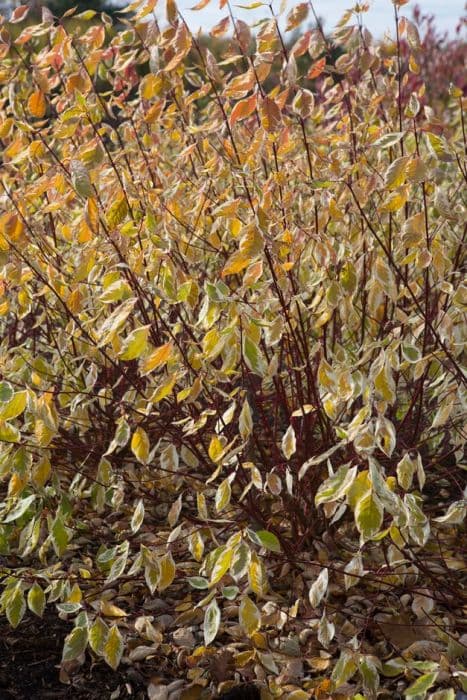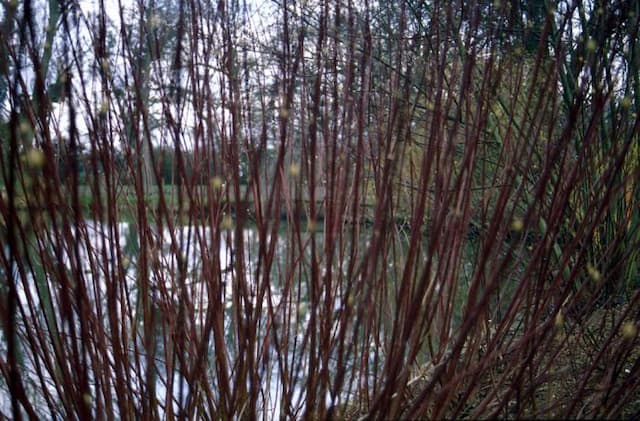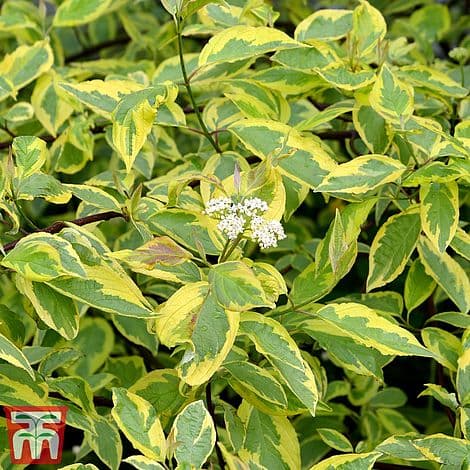Red Osier Dogwood Cornus sericea 'Cardinal'

ABOUT
Cornus sericea 'Cardinal', commonly known as the Red Twig Dogwood 'Cardinal', is recognized for its vibrant red stems that stand out in the winter landscape. During the growing season, its leaves are a lush green which take on warm reddish-purple tones in the fall, before falling off to expose the bright red twigs. Small white flowers bloom in clusters and are followed by white to bluish-white berries that are attractive to birds. The plant's bark, apart from the twigs, is a mix of tans and browns with a smooth to slightly textured feel. Overall, the Red Twig Dogwood 'Cardinal' is praised for its ornamental qualities throughout the year, offering visual interest across the seasons.
About this plant
 Names
NamesSynonyms
Red Osier Dogwood, Red Twig Dogwood, Creek Dogwood, Western Dogwood, American Dogwood, Redstem Dogwood, Red-rood, American Dogwood, Creek Dogwood, Western Dogwood, Red Willow, Redstem Dogwood, Redtwig Dogwood, Redosier Dogwood, Red Brush, Rose Willow, Red Osier, Red-stemmed Dogwood, Western Red Willow, Redstick Dogwood
Common names
Cornus stolonifera 'Cardinal', Swida sericea 'Cardinal'.
 Toxicity
ToxicityTo humans
Red osier dogwood is not typically considered toxic to humans. However, consuming parts of the plant, particularly the fruits, in large quantities can potentially cause minor symptoms such as nausea, vomiting, or diarrhea. It is always advisable to avoid eating parts of ornamental plants due to the potential for stomach upset or other mild gastrointestinal symptoms.
To pets
Red osier dogwood is generally considered to be of low toxicity to pets. While it is not commonly associated with severe poisoning, ingestion might lead to mild gastrointestinal upset in some animals. Symptoms, if they occur, could include vomiting or diarrhea. However, each animal may react differently, and it is always best to prevent pets from consuming plant material not intended for their consumption.
 Characteristics
CharacteristicsLife cycle
Perennials
Foliage type
Deciduous
Color of leaves
Green
Flower color
White
Height
6-9 feet (1.8-2.7 meters)
Spread
5-9 feet (1.5-2.7 meters)
Plant type
Shrub
Hardiness zones
2-9
Native area
North America
Benefits
 General Benefits
General Benefits- Attracts wildlife: Cornus sericea 'Cardinal' provides shelter and food for birds, butterflies, and other beneficial insects.
- Winter interest: With its bright red stems, this plant adds a splash of color to the winter landscape.
- Erosion control: Its dense root system helps to stabilize soil and prevent erosion, particularly on slopes or in wet areas.
- Adaptability: It is adaptable to a variety of soil conditions and can thrive in full sun to partial shade.
- Naturalizing: This shrub spreads over time, creating thickets that can fill in large areas and create a natural, wild-looking landscape.
- Easy to grow: Cornus sericea 'Cardinal' is known for being hardy and relatively low maintenance, making it suitable for both experienced and novice gardeners.
- Seasonal variation: In addition to its winter appeal, it also provides interest in other seasons with flowers in spring and berries in summer.
 Medical Properties
Medical PropertiesThis plant is not used for medical purposes.
 Air-purifying Qualities
Air-purifying QualitiesThis plant is not specifically known for air purifying qualities.
 Other Uses
Other Uses- Wildlife Habitat: Red osier dogwood provides cover and nesting sites for birds and small mammals.
- Natural Dye: The bark can be used to make a light brown or red dye for textiles.
- Photography: The bright red stems of red osier dogwood create a striking contrast in winter landscapes, making it ideal for nature photography.
- Ink Production: Historically, the bark was sometimes used as a source for ink due to its tannin content.
- Winter Interest: The bright stems offer a splash of color in winter gardens, which can be particularly valuable in regions with long, dreary winters.
- Streambank Stabilization: Its root system helps to prevent soil erosion along water bodies.
- Traditional Crafts: Native American tribes used the strong and flexible branches for basket weaving and other traditional crafts.
- Education: It can be used in educational settings to teach about plant propagation, as it roots easily from cuttings.
- Fisheries Improvement: The plant can be used to shade and cool streams, creating better conditions for fish like salmon and trout.
- Cultural Significance: Red osier dogwood holds significance for various Indigenous peoples, being used in ceremonies and as an indicator of seasonal changes.
Interesting Facts
 Feng Shui
Feng ShuiThe Red Twig Dogwood is not used in Feng Shui practice.
 Zodiac Sign Compitability
Zodiac Sign CompitabilityThe Red Twig Dogwood is not used in astrology practice.
 Plant Symbolism
Plant Symbolism- Stability: The Cornus sericea 'Cardinal', commonly known as Red Osier Dogwood, often symbolizes stability and strength, reflecting the sturdy nature of the shrub.
- Growth and Renewal: This plant is deciduous and known for its vibrant red stems that stand out in the winter landscape, symbolizing the idea of new growth and renewal, even during challenging times.
- Protection: Red Osier Dogwood has been traditionally used by Native Americans to make baskets and tools. Its strong wood and resilient growth habit imbue it with a symbolic meaning of protection.
- Hope and Vitality: The bright red color of the stems in the winter can symbolize hope and vitality, representing the promise of life and energy during the dormant season.
 Water
WaterRed Osier Dogwood should be watered deeply but infrequently to encourage deep root growth. In the absence of rain, watering once a week with about 1-2 inches of water should suffice. During hot and dry spells, increase watering to twice a week. Newly planted shrubs require more frequent watering, such as every 2-3 days, until they establish. Reduce watering in late fall to prepare the plant for winter.
 Light
LightRed Osier Dogwood thrives in full sun to partial shade. The ideal spot would receive bright, indirect light or morning sun with some afternoon shade. Avoid deep shade as it will reduce the shrub's vibrant stem color and may lead to fewer flowers.
 Temperature
TemperatureRed Osier Dogwood is hardy and can tolerate a wide range of temperatures, from well below 0°F to about 75°F. This shrub is best adapted to cool to moderate climates and may struggle in extreme heat.
 Pruning
PruningPrune Red Osier Dogwood in late winter or early spring to remove any dead, damaged, or diseased branches. Pruning also helps to maintain the shape of the shrub and encourages the growth of new stems, which have the brightest color. Thin out about a third of the oldest stems annually to promote a rejuvenation of the plant.
 Cleaning
CleaningAs needed
 Soil
SoilRed Osier Dogwood 'Cardinal' prefers well-draining soil rich in organic matter with a pH of 5.5 to 7.5. A mix of loamy soil, peat, compost, and a little sand is ideal to ensure proper drainage and fertility.
 Repotting
RepottingRed Osier Dogwood 'Cardinal' planted in containers may need repotting every 2-3 years to replenish soil nutrients and prevent root crowding, ideally in the spring.
 Humidity & Misting
Humidity & MistingRed Osier Dogwood 'Cardinal' thrives in average humidity conditions. It can tolerate a range of humidity levels commonly found outdoors without specific requirements.
 Suitable locations
Suitable locationsIndoor
Place in bright, indirect light; keep soil moist.
Outdoor
Full sun to partial shade; moist, well-drained soil.
Hardiness zone
2-7 USDA
 Life cycle
Life cycleCornus sericea 'Cardinal', commonly known as Red Osier Dogwood, begins its life as a seed, which after dispersal, typically in the fall or winter, will undergo a period of stratification before it germinates in the spring. Upon germination, the seedling emerges and grows, developing into a young plant with characteristic reddish stems and green foliage. This deciduous shrub enters a vegetative stage, where it experiences rapid growth and branch development throughout the spring and summer. It reaches maturity within a few years, during which it will produce white flowers in late spring to early summer, attracting pollinators. Following pollination, the flowers develop into small white to blueish fruits, which are consumed and dispersed by birds and other wildlife. In the autumn, the leaves turn vibrant shades of red and orange before falling off, and the plant enters dormancy in the winter, completing its annual cycle.
 Propogation
PropogationPropogation time
Late Winter-Early Spring
The most popular method to propagate Cornus sericea 'Cardinal', commonly known as the red twig dogwood, is through softwood cuttings. Propagation is best done in late spring or early summer when the plant's new growth is mature enough yet still tender. Cuttings should be about 4 to 6 inches long with several leaves left at the top. The lower leaves are removed, and the cut end is dipped in rooting hormone to encourage root growth. The prepared cutting is then inserted into a well-draining potting mix, ensuring at least two nodes are buried where leaves were removed. The cutting should be kept in a humid environment with consistent moisture, but not waterlogged, and ideally at a temperature between 65 and 75°F (18-24°C). Roots typically develop within a few weeks, after which the cutting can be transplanted into a larger pot or directly into the garden.









